DIPLOMA NURSING: Assessments 3.3 - Human Body Systems and Health
VerifiedAdded on 2023/01/12
|8
|2529
|2
Homework Assignment
AI Summary
This nursing assignment assesses the student's understanding of human body systems and related health concepts. The assignment begins with an overview of the six levels of structural organization of the human body, followed by descriptions of various life processes such as organization, metabolism, nutrition, biological maturation, inheritance, and aging. The concept of homeostasis, its relationship to disease, and the process of body temperature regulation are then explored. The assignment further delves into the structure and functions of various body components and systems including the cell, skeletal muscle tissue, cardiovascular system, muscular system, skeletal system, endocrine system, nervous system, digestive system, urinary system, reproductive systems, integumentary system, and lymphatic system. The assignment also covers the immune system's lines of defense, the structure and function of the eye and ear, and the senses of smell, and health issues related to mouth and teeth. Finally, the assignment addresses medication administration and procedures like nasogastric tube insertion, including cautions and contraindications. Overall, this assignment provides a comprehensive review of human anatomy, physiology, and related health considerations.

DIPLOMA NURSING
Paraphrase This Document
Need a fresh take? Get an instant paraphrase of this document with our AI Paraphraser
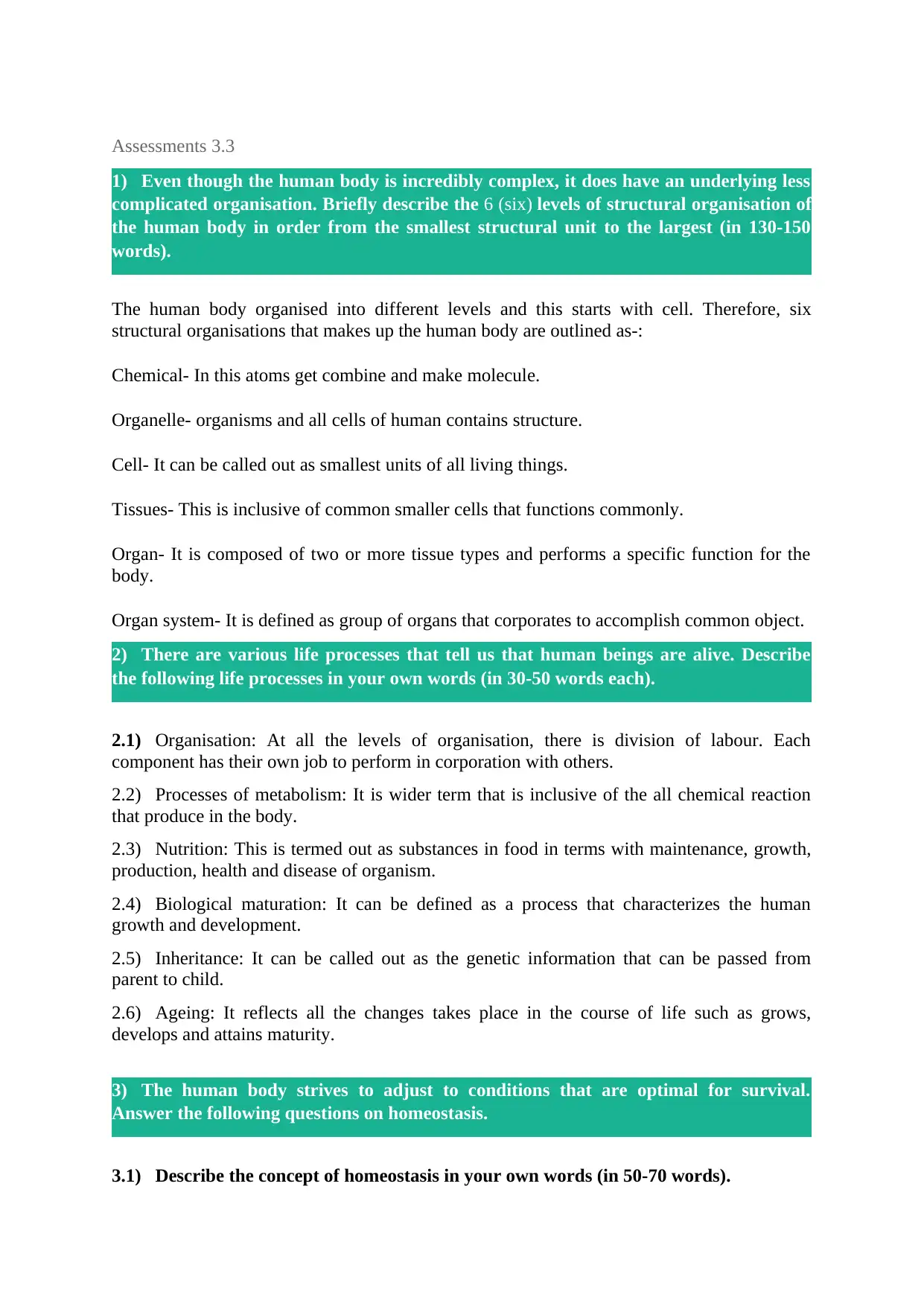
Assessments 3.3
1) Even though the human body is incredibly complex, it does have an underlying less
complicated organisation. Briefly describe the 6 (six) levels of structural organisation of
the human body in order from the smallest structural unit to the largest (in 130-150
words).
The human body organised into different levels and this starts with cell. Therefore, six
structural organisations that makes up the human body are outlined as-:
Chemical- In this atoms get combine and make molecule.
Organelle- organisms and all cells of human contains structure.
Cell- It can be called out as smallest units of all living things.
Tissues- This is inclusive of common smaller cells that functions commonly.
Organ- It is composed of two or more tissue types and performs a specific function for the
body.
Organ system- It is defined as group of organs that corporates to accomplish common object.
2) There are various life processes that tell us that human beings are alive. Describe
the following life processes in your own words (in 30-50 words each).
2.1) Organisation: At all the levels of organisation, there is division of labour. Each
component has their own job to perform in corporation with others.
2.2) Processes of metabolism: It is wider term that is inclusive of the all chemical reaction
that produce in the body.
2.3) Nutrition: This is termed out as substances in food in terms with maintenance, growth,
production, health and disease of organism.
2.4) Biological maturation: It can be defined as a process that characterizes the human
growth and development.
2.5) Inheritance: It can be called out as the genetic information that can be passed from
parent to child.
2.6) Ageing: It reflects all the changes takes place in the course of life such as grows,
develops and attains maturity.
3) The human body strives to adjust to conditions that are optimal for survival.
Answer the following questions on homeostasis.
3.1) Describe the concept of homeostasis in your own words (in 50-70 words).
1) Even though the human body is incredibly complex, it does have an underlying less
complicated organisation. Briefly describe the 6 (six) levels of structural organisation of
the human body in order from the smallest structural unit to the largest (in 130-150
words).
The human body organised into different levels and this starts with cell. Therefore, six
structural organisations that makes up the human body are outlined as-:
Chemical- In this atoms get combine and make molecule.
Organelle- organisms and all cells of human contains structure.
Cell- It can be called out as smallest units of all living things.
Tissues- This is inclusive of common smaller cells that functions commonly.
Organ- It is composed of two or more tissue types and performs a specific function for the
body.
Organ system- It is defined as group of organs that corporates to accomplish common object.
2) There are various life processes that tell us that human beings are alive. Describe
the following life processes in your own words (in 30-50 words each).
2.1) Organisation: At all the levels of organisation, there is division of labour. Each
component has their own job to perform in corporation with others.
2.2) Processes of metabolism: It is wider term that is inclusive of the all chemical reaction
that produce in the body.
2.3) Nutrition: This is termed out as substances in food in terms with maintenance, growth,
production, health and disease of organism.
2.4) Biological maturation: It can be defined as a process that characterizes the human
growth and development.
2.5) Inheritance: It can be called out as the genetic information that can be passed from
parent to child.
2.6) Ageing: It reflects all the changes takes place in the course of life such as grows,
develops and attains maturity.
3) The human body strives to adjust to conditions that are optimal for survival.
Answer the following questions on homeostasis.
3.1) Describe the concept of homeostasis in your own words (in 50-70 words).
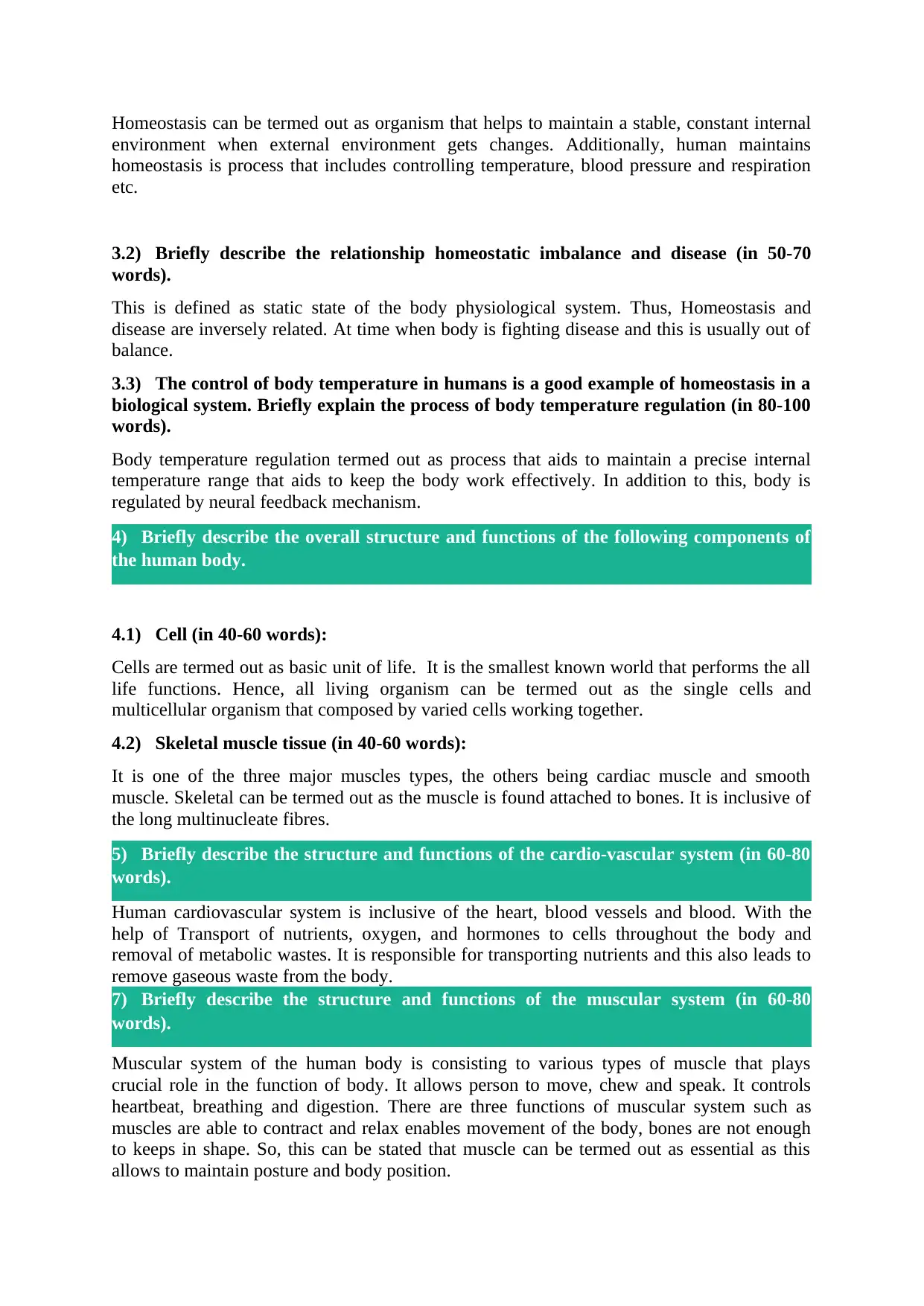
Homeostasis can be termed out as organism that helps to maintain a stable, constant internal
environment when external environment gets changes. Additionally, human maintains
homeostasis is process that includes controlling temperature, blood pressure and respiration
etc.
3.2) Briefly describe the relationship homeostatic imbalance and disease (in 50-70
words).
This is defined as static state of the body physiological system. Thus, Homeostasis and
disease are inversely related. At time when body is fighting disease and this is usually out of
balance.
3.3) The control of body temperature in humans is a good example of homeostasis in a
biological system. Briefly explain the process of body temperature regulation (in 80-100
words).
Body temperature regulation termed out as process that aids to maintain a precise internal
temperature range that aids to keep the body work effectively. In addition to this, body is
regulated by neural feedback mechanism.
4) Briefly describe the overall structure and functions of the following components of
the human body.
4.1) Cell (in 40-60 words):
Cells are termed out as basic unit of life. It is the smallest known world that performs the all
life functions. Hence, all living organism can be termed out as the single cells and
multicellular organism that composed by varied cells working together.
4.2) Skeletal muscle tissue (in 40-60 words):
It is one of the three major muscles types, the others being cardiac muscle and smooth
muscle. Skeletal can be termed out as the muscle is found attached to bones. It is inclusive of
the long multinucleate fibres.
5) Briefly describe the structure and functions of the cardio-vascular system (in 60-80
words).
Human cardiovascular system is inclusive of the heart, blood vessels and blood. With the
help of Transport of nutrients, oxygen, and hormones to cells throughout the body and
removal of metabolic wastes. It is responsible for transporting nutrients and this also leads to
remove gaseous waste from the body.
7) Briefly describe the structure and functions of the muscular system (in 60-80
words).
Muscular system of the human body is consisting to various types of muscle that plays
crucial role in the function of body. It allows person to move, chew and speak. It controls
heartbeat, breathing and digestion. There are three functions of muscular system such as
muscles are able to contract and relax enables movement of the body, bones are not enough
to keeps in shape. So, this can be stated that muscle can be termed out as essential as this
allows to maintain posture and body position.
environment when external environment gets changes. Additionally, human maintains
homeostasis is process that includes controlling temperature, blood pressure and respiration
etc.
3.2) Briefly describe the relationship homeostatic imbalance and disease (in 50-70
words).
This is defined as static state of the body physiological system. Thus, Homeostasis and
disease are inversely related. At time when body is fighting disease and this is usually out of
balance.
3.3) The control of body temperature in humans is a good example of homeostasis in a
biological system. Briefly explain the process of body temperature regulation (in 80-100
words).
Body temperature regulation termed out as process that aids to maintain a precise internal
temperature range that aids to keep the body work effectively. In addition to this, body is
regulated by neural feedback mechanism.
4) Briefly describe the overall structure and functions of the following components of
the human body.
4.1) Cell (in 40-60 words):
Cells are termed out as basic unit of life. It is the smallest known world that performs the all
life functions. Hence, all living organism can be termed out as the single cells and
multicellular organism that composed by varied cells working together.
4.2) Skeletal muscle tissue (in 40-60 words):
It is one of the three major muscles types, the others being cardiac muscle and smooth
muscle. Skeletal can be termed out as the muscle is found attached to bones. It is inclusive of
the long multinucleate fibres.
5) Briefly describe the structure and functions of the cardio-vascular system (in 60-80
words).
Human cardiovascular system is inclusive of the heart, blood vessels and blood. With the
help of Transport of nutrients, oxygen, and hormones to cells throughout the body and
removal of metabolic wastes. It is responsible for transporting nutrients and this also leads to
remove gaseous waste from the body.
7) Briefly describe the structure and functions of the muscular system (in 60-80
words).
Muscular system of the human body is consisting to various types of muscle that plays
crucial role in the function of body. It allows person to move, chew and speak. It controls
heartbeat, breathing and digestion. There are three functions of muscular system such as
muscles are able to contract and relax enables movement of the body, bones are not enough
to keeps in shape. So, this can be stated that muscle can be termed out as essential as this
allows to maintain posture and body position.
⊘ This is a preview!⊘
Do you want full access?
Subscribe today to unlock all pages.

Trusted by 1+ million students worldwide
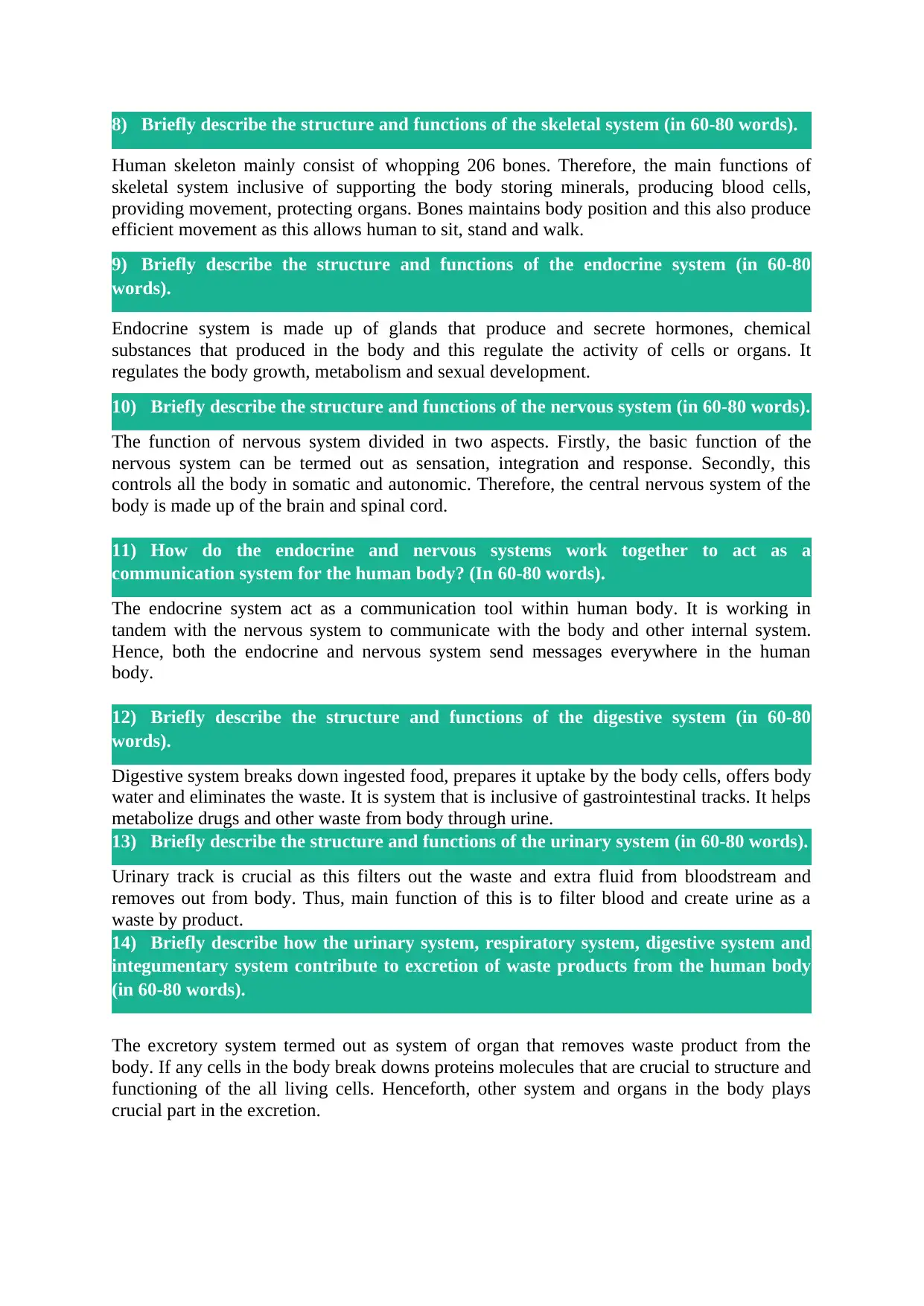
8) Briefly describe the structure and functions of the skeletal system (in 60-80 words).
Human skeleton mainly consist of whopping 206 bones. Therefore, the main functions of
skeletal system inclusive of supporting the body storing minerals, producing blood cells,
providing movement, protecting organs. Bones maintains body position and this also produce
efficient movement as this allows human to sit, stand and walk.
9) Briefly describe the structure and functions of the endocrine system (in 60-80
words).
Endocrine system is made up of glands that produce and secrete hormones, chemical
substances that produced in the body and this regulate the activity of cells or organs. It
regulates the body growth, metabolism and sexual development.
10) Briefly describe the structure and functions of the nervous system (in 60-80 words).
The function of nervous system divided in two aspects. Firstly, the basic function of the
nervous system can be termed out as sensation, integration and response. Secondly, this
controls all the body in somatic and autonomic. Therefore, the central nervous system of the
body is made up of the brain and spinal cord.
11) How do the endocrine and nervous systems work together to act as a
communication system for the human body? (In 60-80 words).
The endocrine system act as a communication tool within human body. It is working in
tandem with the nervous system to communicate with the body and other internal system.
Hence, both the endocrine and nervous system send messages everywhere in the human
body.
12) Briefly describe the structure and functions of the digestive system (in 60-80
words).
Digestive system breaks down ingested food, prepares it uptake by the body cells, offers body
water and eliminates the waste. It is system that is inclusive of gastrointestinal tracks. It helps
metabolize drugs and other waste from body through urine.
13) Briefly describe the structure and functions of the urinary system (in 60-80 words).
Urinary track is crucial as this filters out the waste and extra fluid from bloodstream and
removes out from body. Thus, main function of this is to filter blood and create urine as a
waste by product.
14) Briefly describe how the urinary system, respiratory system, digestive system and
integumentary system contribute to excretion of waste products from the human body
(in 60-80 words).
The excretory system termed out as system of organ that removes waste product from the
body. If any cells in the body break downs proteins molecules that are crucial to structure and
functioning of the all living cells. Henceforth, other system and organs in the body plays
crucial part in the excretion.
Human skeleton mainly consist of whopping 206 bones. Therefore, the main functions of
skeletal system inclusive of supporting the body storing minerals, producing blood cells,
providing movement, protecting organs. Bones maintains body position and this also produce
efficient movement as this allows human to sit, stand and walk.
9) Briefly describe the structure and functions of the endocrine system (in 60-80
words).
Endocrine system is made up of glands that produce and secrete hormones, chemical
substances that produced in the body and this regulate the activity of cells or organs. It
regulates the body growth, metabolism and sexual development.
10) Briefly describe the structure and functions of the nervous system (in 60-80 words).
The function of nervous system divided in two aspects. Firstly, the basic function of the
nervous system can be termed out as sensation, integration and response. Secondly, this
controls all the body in somatic and autonomic. Therefore, the central nervous system of the
body is made up of the brain and spinal cord.
11) How do the endocrine and nervous systems work together to act as a
communication system for the human body? (In 60-80 words).
The endocrine system act as a communication tool within human body. It is working in
tandem with the nervous system to communicate with the body and other internal system.
Hence, both the endocrine and nervous system send messages everywhere in the human
body.
12) Briefly describe the structure and functions of the digestive system (in 60-80
words).
Digestive system breaks down ingested food, prepares it uptake by the body cells, offers body
water and eliminates the waste. It is system that is inclusive of gastrointestinal tracks. It helps
metabolize drugs and other waste from body through urine.
13) Briefly describe the structure and functions of the urinary system (in 60-80 words).
Urinary track is crucial as this filters out the waste and extra fluid from bloodstream and
removes out from body. Thus, main function of this is to filter blood and create urine as a
waste by product.
14) Briefly describe how the urinary system, respiratory system, digestive system and
integumentary system contribute to excretion of waste products from the human body
(in 60-80 words).
The excretory system termed out as system of organ that removes waste product from the
body. If any cells in the body break downs proteins molecules that are crucial to structure and
functioning of the all living cells. Henceforth, other system and organs in the body plays
crucial part in the excretion.
Paraphrase This Document
Need a fresh take? Get an instant paraphrase of this document with our AI Paraphraser
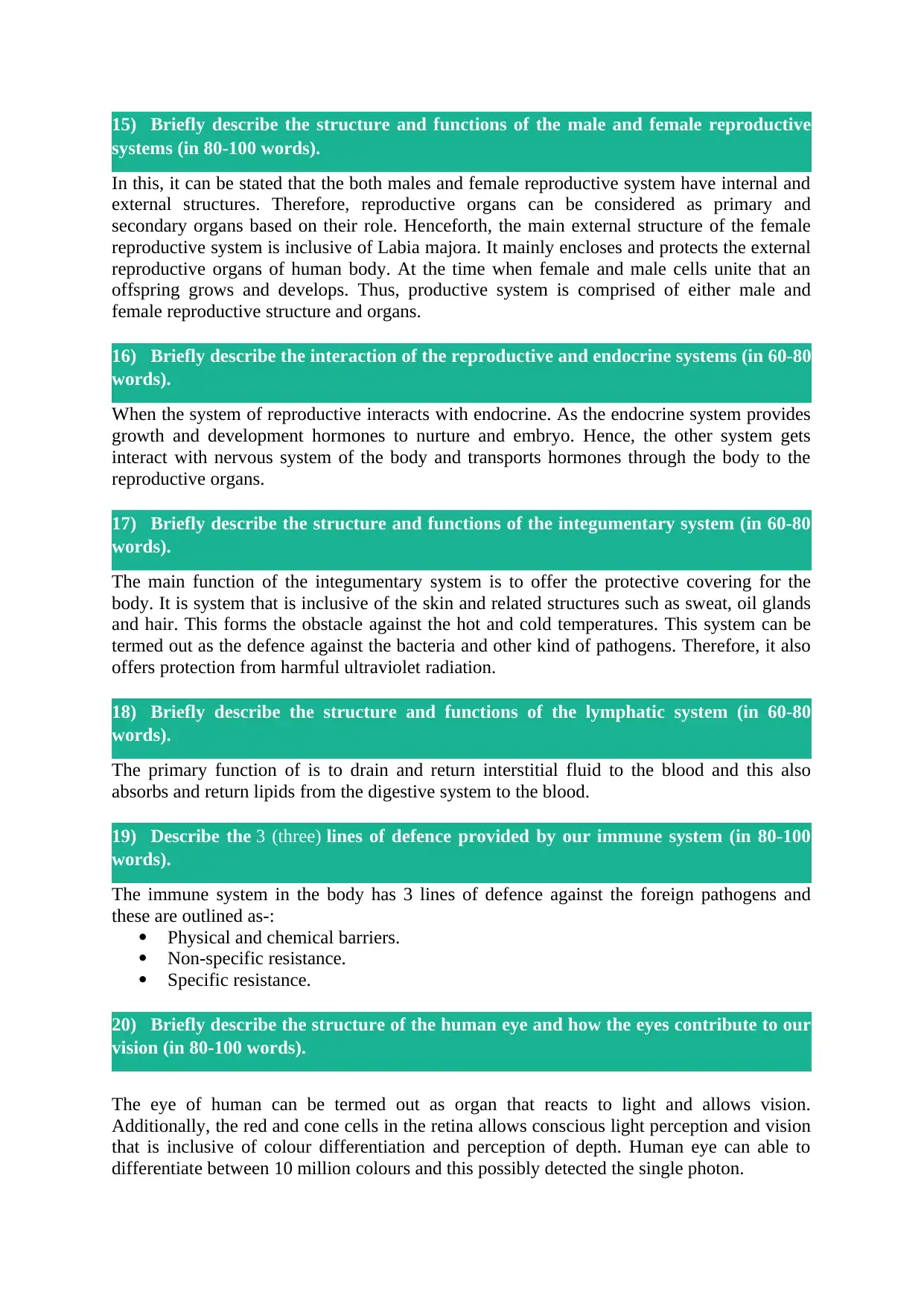
15) Briefly describe the structure and functions of the male and female reproductive
systems (in 80-100 words).
In this, it can be stated that the both males and female reproductive system have internal and
external structures. Therefore, reproductive organs can be considered as primary and
secondary organs based on their role. Henceforth, the main external structure of the female
reproductive system is inclusive of Labia majora. It mainly encloses and protects the external
reproductive organs of human body. At the time when female and male cells unite that an
offspring grows and develops. Thus, productive system is comprised of either male and
female reproductive structure and organs.
16) Briefly describe the interaction of the reproductive and endocrine systems (in 60-80
words).
When the system of reproductive interacts with endocrine. As the endocrine system provides
growth and development hormones to nurture and embryo. Hence, the other system gets
interact with nervous system of the body and transports hormones through the body to the
reproductive organs.
17) Briefly describe the structure and functions of the integumentary system (in 60-80
words).
The main function of the integumentary system is to offer the protective covering for the
body. It is system that is inclusive of the skin and related structures such as sweat, oil glands
and hair. This forms the obstacle against the hot and cold temperatures. This system can be
termed out as the defence against the bacteria and other kind of pathogens. Therefore, it also
offers protection from harmful ultraviolet radiation.
18) Briefly describe the structure and functions of the lymphatic system (in 60-80
words).
The primary function of is to drain and return interstitial fluid to the blood and this also
absorbs and return lipids from the digestive system to the blood.
19) Describe the 3 (three) lines of defence provided by our immune system (in 80-100
words).
The immune system in the body has 3 lines of defence against the foreign pathogens and
these are outlined as-:
Physical and chemical barriers.
Non-specific resistance.
Specific resistance.
20) Briefly describe the structure of the human eye and how the eyes contribute to our
vision (in 80-100 words).
The eye of human can be termed out as organ that reacts to light and allows vision.
Additionally, the red and cone cells in the retina allows conscious light perception and vision
that is inclusive of colour differentiation and perception of depth. Human eye can able to
differentiate between 10 million colours and this possibly detected the single photon.
systems (in 80-100 words).
In this, it can be stated that the both males and female reproductive system have internal and
external structures. Therefore, reproductive organs can be considered as primary and
secondary organs based on their role. Henceforth, the main external structure of the female
reproductive system is inclusive of Labia majora. It mainly encloses and protects the external
reproductive organs of human body. At the time when female and male cells unite that an
offspring grows and develops. Thus, productive system is comprised of either male and
female reproductive structure and organs.
16) Briefly describe the interaction of the reproductive and endocrine systems (in 60-80
words).
When the system of reproductive interacts with endocrine. As the endocrine system provides
growth and development hormones to nurture and embryo. Hence, the other system gets
interact with nervous system of the body and transports hormones through the body to the
reproductive organs.
17) Briefly describe the structure and functions of the integumentary system (in 60-80
words).
The main function of the integumentary system is to offer the protective covering for the
body. It is system that is inclusive of the skin and related structures such as sweat, oil glands
and hair. This forms the obstacle against the hot and cold temperatures. This system can be
termed out as the defence against the bacteria and other kind of pathogens. Therefore, it also
offers protection from harmful ultraviolet radiation.
18) Briefly describe the structure and functions of the lymphatic system (in 60-80
words).
The primary function of is to drain and return interstitial fluid to the blood and this also
absorbs and return lipids from the digestive system to the blood.
19) Describe the 3 (three) lines of defence provided by our immune system (in 80-100
words).
The immune system in the body has 3 lines of defence against the foreign pathogens and
these are outlined as-:
Physical and chemical barriers.
Non-specific resistance.
Specific resistance.
20) Briefly describe the structure of the human eye and how the eyes contribute to our
vision (in 80-100 words).
The eye of human can be termed out as organ that reacts to light and allows vision.
Additionally, the red and cone cells in the retina allows conscious light perception and vision
that is inclusive of colour differentiation and perception of depth. Human eye can able to
differentiate between 10 million colours and this possibly detected the single photon.
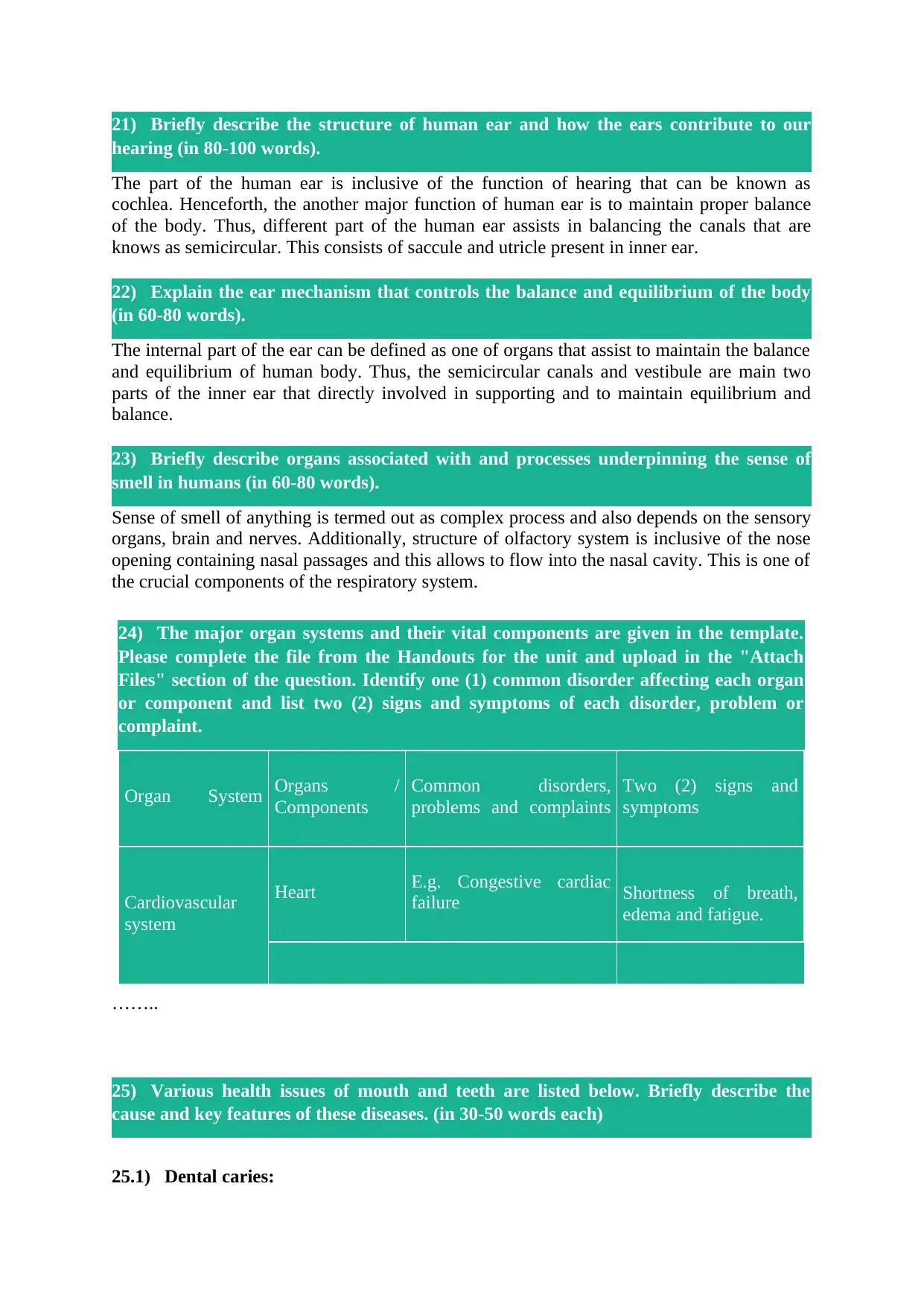
21) Briefly describe the structure of human ear and how the ears contribute to our
hearing (in 80-100 words).
The part of the human ear is inclusive of the function of hearing that can be known as
cochlea. Henceforth, the another major function of human ear is to maintain proper balance
of the body. Thus, different part of the human ear assists in balancing the canals that are
knows as semicircular. This consists of saccule and utricle present in inner ear.
22) Explain the ear mechanism that controls the balance and equilibrium of the body
(in 60-80 words).
The internal part of the ear can be defined as one of organs that assist to maintain the balance
and equilibrium of human body. Thus, the semicircular canals and vestibule are main two
parts of the inner ear that directly involved in supporting and to maintain equilibrium and
balance.
23) Briefly describe organs associated with and processes underpinning the sense of
smell in humans (in 60-80 words).
Sense of smell of anything is termed out as complex process and also depends on the sensory
organs, brain and nerves. Additionally, structure of olfactory system is inclusive of the nose
opening containing nasal passages and this allows to flow into the nasal cavity. This is one of
the crucial components of the respiratory system.
24
24) The major organ systems and their vital components are given in the template.
Please complete the file from the Handouts for the unit and upload in the "Attach
Files" section of the question. Identify one (1) common disorder affecting each organ
or component and list two (2) signs and symptoms of each disorder, problem or
complaint.
Organ System Organs /
Components
Common disorders,
problems and complaints
Two (2) signs and
symptoms
Cardiovascular
system
Heart E.g. Congestive cardiac
failure Shortness of breath,
edema and fatigue.
……..
25) Various health issues of mouth and teeth are listed below. Briefly describe the
cause and key features of these diseases. (in 30-50 words each)
25.1) Dental caries:
hearing (in 80-100 words).
The part of the human ear is inclusive of the function of hearing that can be known as
cochlea. Henceforth, the another major function of human ear is to maintain proper balance
of the body. Thus, different part of the human ear assists in balancing the canals that are
knows as semicircular. This consists of saccule and utricle present in inner ear.
22) Explain the ear mechanism that controls the balance and equilibrium of the body
(in 60-80 words).
The internal part of the ear can be defined as one of organs that assist to maintain the balance
and equilibrium of human body. Thus, the semicircular canals and vestibule are main two
parts of the inner ear that directly involved in supporting and to maintain equilibrium and
balance.
23) Briefly describe organs associated with and processes underpinning the sense of
smell in humans (in 60-80 words).
Sense of smell of anything is termed out as complex process and also depends on the sensory
organs, brain and nerves. Additionally, structure of olfactory system is inclusive of the nose
opening containing nasal passages and this allows to flow into the nasal cavity. This is one of
the crucial components of the respiratory system.
24
24) The major organ systems and their vital components are given in the template.
Please complete the file from the Handouts for the unit and upload in the "Attach
Files" section of the question. Identify one (1) common disorder affecting each organ
or component and list two (2) signs and symptoms of each disorder, problem or
complaint.
Organ System Organs /
Components
Common disorders,
problems and complaints
Two (2) signs and
symptoms
Cardiovascular
system
Heart E.g. Congestive cardiac
failure Shortness of breath,
edema and fatigue.
……..
25) Various health issues of mouth and teeth are listed below. Briefly describe the
cause and key features of these diseases. (in 30-50 words each)
25.1) Dental caries:
⊘ This is a preview!⊘
Do you want full access?
Subscribe today to unlock all pages.

Trusted by 1+ million students worldwide
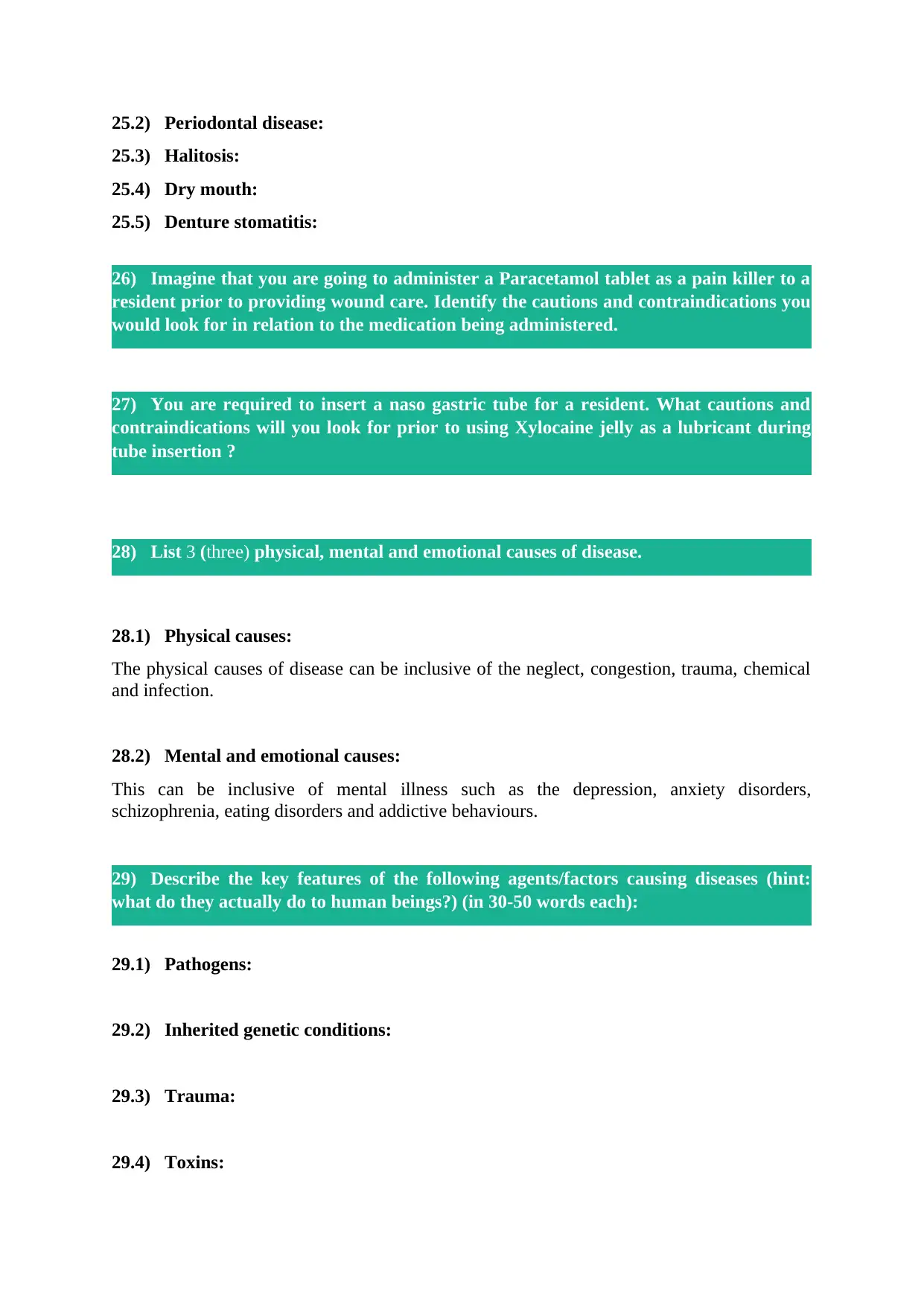
25.2) Periodontal disease:
25.3) Halitosis:
25.4) Dry mouth:
25.5) Denture stomatitis:
26) Imagine that you are going to administer a Paracetamol tablet as a pain killer to a
resident prior to providing wound care. Identify the cautions and contraindications you
would look for in relation to the medication being administered.
27) You are required to insert a naso gastric tube for a resident. What cautions and
contraindications will you look for prior to using Xylocaine jelly as a lubricant during
tube insertion ?
28) List 3 (three) physical, mental and emotional causes of disease.
28.1) Physical causes:
The physical causes of disease can be inclusive of the neglect, congestion, trauma, chemical
and infection.
28.2) Mental and emotional causes:
This can be inclusive of mental illness such as the depression, anxiety disorders,
schizophrenia, eating disorders and addictive behaviours.
29) Describe the key features of the following agents/factors causing diseases (hint:
what do they actually do to human beings?) (in 30-50 words each):
29.1) Pathogens:
29.2) Inherited genetic conditions:
29.3) Trauma:
29.4) Toxins:
25.3) Halitosis:
25.4) Dry mouth:
25.5) Denture stomatitis:
26) Imagine that you are going to administer a Paracetamol tablet as a pain killer to a
resident prior to providing wound care. Identify the cautions and contraindications you
would look for in relation to the medication being administered.
27) You are required to insert a naso gastric tube for a resident. What cautions and
contraindications will you look for prior to using Xylocaine jelly as a lubricant during
tube insertion ?
28) List 3 (three) physical, mental and emotional causes of disease.
28.1) Physical causes:
The physical causes of disease can be inclusive of the neglect, congestion, trauma, chemical
and infection.
28.2) Mental and emotional causes:
This can be inclusive of mental illness such as the depression, anxiety disorders,
schizophrenia, eating disorders and addictive behaviours.
29) Describe the key features of the following agents/factors causing diseases (hint:
what do they actually do to human beings?) (in 30-50 words each):
29.1) Pathogens:
29.2) Inherited genetic conditions:
29.3) Trauma:
29.4) Toxins:
Paraphrase This Document
Need a fresh take? Get an instant paraphrase of this document with our AI Paraphraser
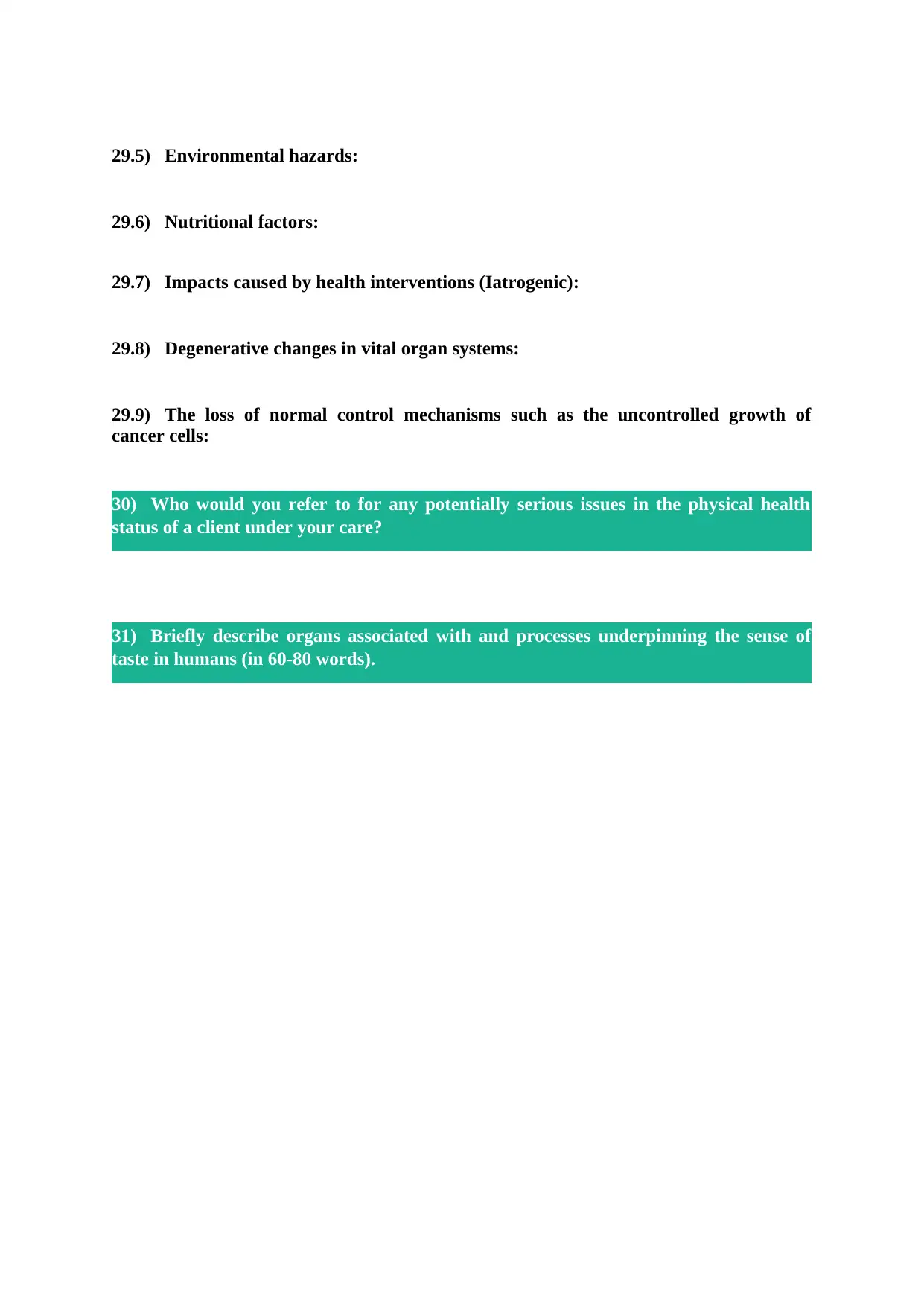
29.5) Environmental hazards:
29.6) Nutritional factors:
29.7) Impacts caused by health interventions (Iatrogenic):
29.8) Degenerative changes in vital organ systems:
29.9) The loss of normal control mechanisms such as the uncontrolled growth of
cancer cells:
30) Who would you refer to for any potentially serious issues in the physical health
status of a client under your care?
31) Briefly describe organs associated with and processes underpinning the sense of
taste in humans (in 60-80 words).
29.6) Nutritional factors:
29.7) Impacts caused by health interventions (Iatrogenic):
29.8) Degenerative changes in vital organ systems:
29.9) The loss of normal control mechanisms such as the uncontrolled growth of
cancer cells:
30) Who would you refer to for any potentially serious issues in the physical health
status of a client under your care?
31) Briefly describe organs associated with and processes underpinning the sense of
taste in humans (in 60-80 words).
1 out of 8
Related Documents
Your All-in-One AI-Powered Toolkit for Academic Success.
+13062052269
info@desklib.com
Available 24*7 on WhatsApp / Email
![[object Object]](/_next/static/media/star-bottom.7253800d.svg)
Unlock your academic potential
Copyright © 2020–2025 A2Z Services. All Rights Reserved. Developed and managed by ZUCOL.





